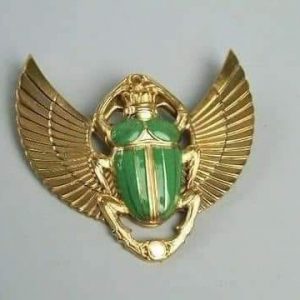Have you ever thought about what is called a scarab?

What is the secret of its frequent use in the ancient Egyptian civilization, whether in art, religion, or jewellery? All of them were inspired by the scarab themes and shapes we now stand in front of and amaze. So together, let’s get to know the scarab.
The scarab was called in the ancient Egyptian language as news, meaning that it is – becomes – comes into existence, and they are all related to resurrection and the new life.
The scarab was the most famous amulet in ancient Egypt, and it was of such importance for several reasons, including
1- It is that the ancient Egyptian, when he noticed the environment around him, found the scarab pushing his dung ball in front of him, so he connected the dung ball with the sun disk. So the scarab became similar to the god Raf, and the scarab became carrying the symbolism of life and resurrection, which are the features and symbolism of the sun.
2- The Egyptian also noticed that from that ball, he came out and generated small beetles from it, but he did not know how to reproduce or mate, so he linked it to the creative deities themselves, like Atum
The scarab includes various types, such as
• The scarab amulet, which was used as an amulet
• The scarab that is used as a stamp
The memorial scarab is used to commemorate certain actions.
• The heart scarab, which is the most famous type of scarab, is a heart-shaped scarab that was placed under the mummy scrolls
The shape of the scarab did not remain constant throughout the ancient Egyptian civilization. At the beginning of the formation of the scarab did not include the anatomical features of the scarab, i.e. it was scaled, but since the late Middle Kingdom, the ancient Egyptian began to add to it some anatomical features such as the front legs that were pushing the ball of dung. Since the modern state began, the Egyptian artist He excels in forming scarabs, highlighting all its details. Another shape appeared the winged scarab, leaving us with the ancient Egyptian wonderful masterpieces of his art.

Comment (0)